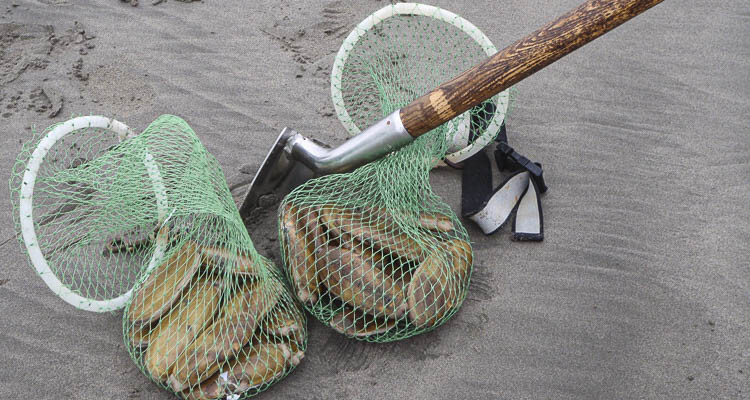
Additional digs planned for January and February
OLYMPIA – Razor clam diggers can look forward to more digging on coastal beaches beginning Jan. 9, Washington Department of Fish and Wildlife (WDFW) coastal shellfish managers confirmed today (Jan. 4).
“There was high surf during the last tide series of 2023, resulting in some difficult digging at times,” said Bryce Blumenthal, a WDFW coastal shellfish biologist. “Hopefully the start of 2024 brings better conditions and easier razor clam digging.”
Not all coastal beaches are open for every dig, so diggers are encouraged to make sure their intended destination is open before heading out. Optimal digging occurs between one and two hours before the listed time of low tide.
The following digs during afternoon and evening low tides (noon to midnight only) will proceed as scheduled, after marine toxin results from the Washington State Department of Health (DOH) showed razor clams are safe to eat:
- Jan. 9, Tuesday, 5:02 p.m.; -0.7 feet; Long Beach, Copalis
- Jan. 10, Wednesday, 5:46 p.m.; -1.2 feet; Long Beach, Twin Harbors, Mocrocks
- Jan. 11, Thursday, 6:28 p.m.; -1.5 feet; Long Beach, Twin Harbors, Mocrocks
- Jan. 12, Friday, 7:11 p.m.; -1.6 feet; Long Beach, Twin Harbors, Copalis
- Jan. 13, Saturday, 7:53 p.m.; -1.3 feet; Long Beach, Twin Harbors, Copalis
- Jan. 14, Sunday, 8:36 p.m.; -0.8 feet; Long Beach, Twin Harbors, Mocrocks
- Jan. 15, Monday, 9:19 p.m.; 0.0 feet; Mocrocks
The DOH requires test samples for marine toxins, and domoic acid levels must fall under the guideline level before a beach can open for digging. Domoic acid, a natural toxin produced by certain types of marine algae, can be harmful or fatal if consumed in sufficient quantities. Final approval usually occurs about a week or less – sometimes two to three days – before the start of each digging series. More information about domoic acid, as well as current levels at ocean beaches, can be found on the WDFW’s domoic acid webpage.
Additional tentative dates in January and February:
- Jan. 22, Monday, 4:28 p.m.; -0.1 feet; Mocrocks
- Jan. 23, Tuesday, 5:13 p.m.; -0.3 feet; Long Beach, Twin Harbors, Mocrocks
- Jan. 24, Wednesday, 5:53 p.m.; -0.4 feet; Long Beach, Twin Harbors, Copalis
- Jan. 25, Thursday, 6:28 p.m.; -0.4 feet; Long Beach, Twin Harbors, Copalis
- Jan. 26, Friday, 7:01 p.m.; -0.2 feet; Long Beach, Twin Harbors, Mocrocks
- Jan. 27, Saturday, 7:32 p.m.; 0.0 feet; Long Beach, Mocrocks
- Jan. 28, Sunday, 8:02 p.m.; 0.4 feet; Copalis
- Feb. 6, Tuesday, 3:52 p.m.; 0.0 feet; Mocrocks
- Feb. 7, Wednesday, 4:41 p.m.; -0.7 feet; Long Beach, Twin Harbors, Copalis
- Feb. 8, Thursday, 5:26 p.m.; -1.2 feet; Long Beach, Twin Harbors, Copalis
- Feb. 9, Friday, 6:09 p.m.; -1.4 feet; Long Beach, Twin Harbors, Mocrocks
- Feb. 10, Saturday, 6:49 p.m.; -1.4 feet; Long Beach, Twin Harbors, Mocrocks
- Feb. 11, Sunday, 7:29 p.m.; -1.0 feet; Long Beach, Twin Harbors, Copalis
- Feb. 12, Monday, 8:08 p.m.; -0.3 feet; Long Beach, Copalis
- Feb. 21, Wednesday, 4:56 p.m.; 0.2 feet; Long Beach, Twin Harbors, Mocrocks
- Feb. 22, Thursday, 5:33 p.m.; 0.1 feet; Long Beach, Twin Harbors, Mocrocks
- Feb. 23, Friday, 6:05 p.m.; 0.1 feet; Long Beach, Twin Harbors, Copalis
- Feb. 24, Saturday, 6:34 p.m.; 0.2 feet; Long Beach, Twin Harbors, Copalis
- Feb. 25, Sunday, 7:02 p.m.; 0.4 feet; Long Beach, Mocrocks
WDFW is accepting public comments on the alternative digging schedule change at Copalis and Mocrocks beaches during January and February. The public may email their feedback to razorclams@dfw.wa.gov.
On all open beaches, the daily limit is 15 clams per person. Each digger’s clams must be kept in a separate container, and all diggers must keep the first 15 clams they dig, regardless of size or condition, to prevent waste.
All diggers 15 or older must have an applicable fishing license to harvest razor clams on any beach. Licenses can be purchased from WDFW’s licensing website, and from hundreds of license vendors around the state. WDFW recommends buying your license before visiting coastal beach communities. Additional razor clam information is available on the WDFW razor clam webpage.
The Washington Department of Fish and Wildlife works to preserve, protect, and perpetuate fish, wildlife and ecosystems while providing sustainable fish and wildlife recreational and commercial opportunities.
Also read:
- The Study of Sports Podcast, May 8, 2025: Girls flag football is coming to Washington high schools, but how do administrators start a new sport?Reporter Paul Valencia and sports administrators Tony Liberatore and Cale Piland discuss local sports first, and we have fun with other topics, too, including news about a famous burger restaurant coming to Vancouver
- Changing roles: Brian Witherspoon accepts position as head coach of Camas girls basketballBrian Witherspoon has been hired to lead the Camas girls basketball program after serving as interim boys coach last season.
- Former Vancouver sports administrator, now working in Nevada, predicts big things for girls flag footballAlbert Alcantar, now in Las Vegas, says Washington’s new WIAA-sanctioned girls flag football program could mirror the success Nevada has already seen.
- Vancouver selected for National Million Coaches ChallengeVancouver Parks and Recreation has been chosen to participate in the Million Coaches Challenge, a national initiative to train youth sports coaches in inclusive, developmentally focused practices.
- WDFW approves eight days of coastal razor clam digs beginning April 26WDFW has approved eight days of razor clam digs beginning April 26, with tentative final digs set for May 10–15, pending marine toxin test results.









